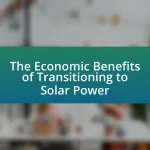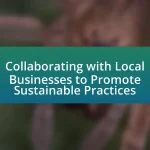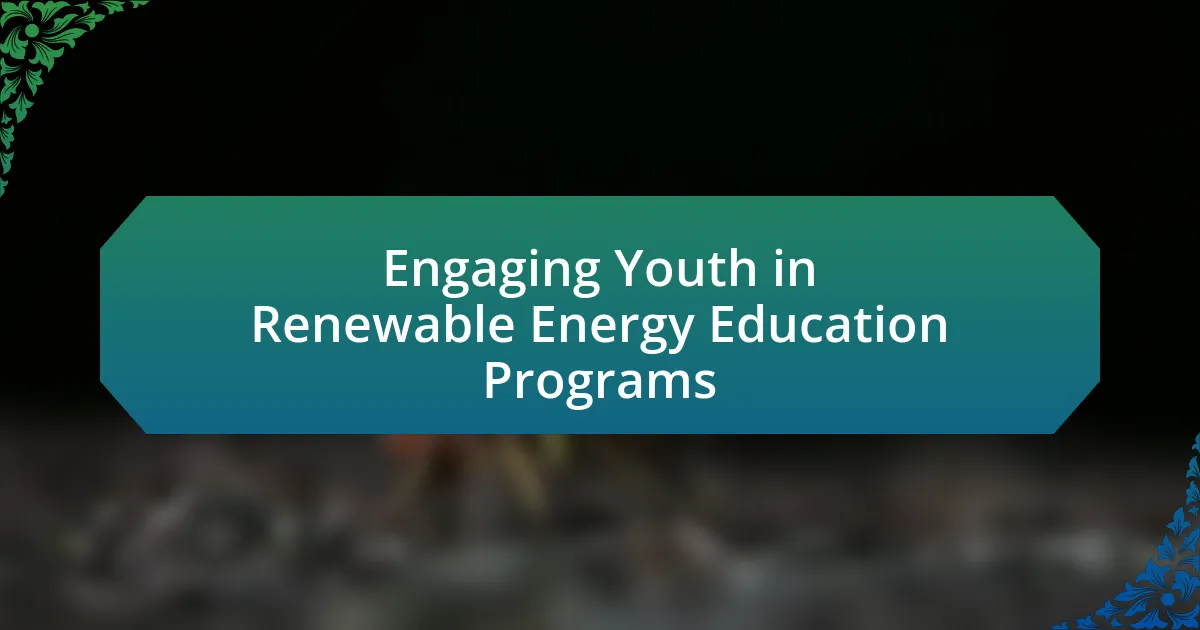The article focuses on strategies for effective communication in renewable energy advocacy, emphasizing the importance of tailoring messages to specific audiences, using clear language, and leveraging storytelling to enhance engagement. It discusses how personal narratives can influence public perception and the role of audience analysis in crafting impactful messages. Additionally, the article addresses challenges such as misinformation and skepticism, while outlining best practices for collaboration and the use of technology to improve communication outcomes. Key metrics for evaluating communication effectiveness and practical tips for advocates are also provided to enhance the overall impact of renewable energy messaging.
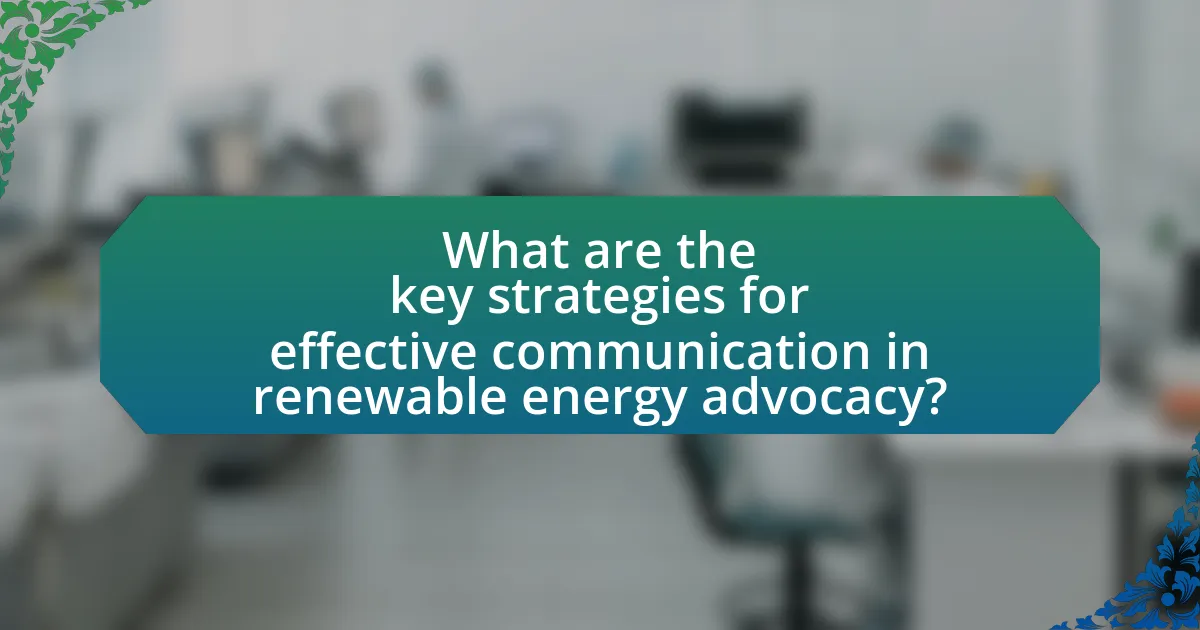
What are the key strategies for effective communication in renewable energy advocacy?
Key strategies for effective communication in renewable energy advocacy include tailoring messages to specific audiences, utilizing clear and accessible language, and leveraging storytelling to convey the benefits of renewable energy. Tailoring messages ensures that the information resonates with the audience’s values and concerns, which is supported by research indicating that targeted communication increases engagement and understanding. Clear language avoids technical jargon, making the information more accessible; studies show that simpler communication leads to higher retention rates. Additionally, storytelling can create emotional connections, as narratives about personal experiences with renewable energy have been shown to enhance persuasion and motivate action.
How can storytelling enhance renewable energy advocacy efforts?
Storytelling can enhance renewable energy advocacy efforts by creating emotional connections that resonate with audiences, making complex information more relatable and memorable. By using narratives that illustrate the benefits of renewable energy, such as personal stories of individuals or communities positively impacted by clean energy initiatives, advocates can effectively engage their audience. Research indicates that stories can increase information retention by up to 65%, as they allow listeners to visualize scenarios and empathize with characters, thereby fostering a deeper understanding of the issues at hand. This emotional engagement can lead to increased public support and action towards renewable energy initiatives.
What elements make a compelling story in renewable energy communication?
A compelling story in renewable energy communication includes relatable characters, clear conflict, and a resolution that emphasizes the benefits of renewable energy. Relatable characters, such as individuals or communities affected by energy issues, create emotional connections with the audience. Clear conflict, such as the challenges posed by fossil fuels or climate change, engages the audience’s attention. A resolution that highlights successful renewable energy solutions, supported by statistics showing their effectiveness—like the International Renewable Energy Agency’s report indicating that renewable energy jobs reached 11.5 million globally in 2018—demonstrates the positive impact of these solutions. This combination of elements effectively conveys the urgency and importance of transitioning to renewable energy.
How can personal narratives influence public perception of renewable energy?
Personal narratives can significantly influence public perception of renewable energy by making complex issues relatable and emotionally engaging. When individuals share their personal experiences with renewable energy—such as the benefits of solar panels in reducing energy bills or the impact of wind farms on local communities—they humanize the topic and create a connection with the audience. Research indicates that stories can evoke empathy and motivate action; for instance, a study published in the journal “Environmental Communication” found that narratives can enhance understanding and support for renewable energy initiatives by illustrating real-life benefits and challenges. This emotional resonance can shift public attitudes, making renewable energy more appealing and acceptable.
What role does audience analysis play in communication strategies?
Audience analysis is crucial in communication strategies as it enables the tailoring of messages to meet the specific needs, preferences, and characteristics of the target audience. By understanding the demographics, values, and motivations of the audience, communicators can craft messages that resonate more effectively, increasing engagement and comprehension. Research indicates that targeted communication can improve message retention by up to 50%, demonstrating the importance of audience analysis in enhancing the effectiveness of communication strategies.
How can understanding audience demographics improve messaging?
Understanding audience demographics can significantly improve messaging by allowing communicators to tailor their content to the specific characteristics, preferences, and values of their target audience. For instance, research indicates that messages about renewable energy resonate more with younger audiences who prioritize sustainability, while older demographics may respond better to economic benefits and energy independence. By analyzing demographic data such as age, income, education level, and geographic location, advocates can craft messages that align with the interests and concerns of different groups, thereby increasing engagement and effectiveness. This targeted approach is supported by studies showing that personalized messaging can lead to higher conversion rates and greater public support for renewable energy initiatives.
What techniques can be used to tailor messages for different stakeholders?
Techniques to tailor messages for different stakeholders include audience analysis, message framing, and the use of storytelling. Audience analysis involves understanding the specific interests, values, and concerns of each stakeholder group, which allows for customized communication that resonates with them. Message framing refers to presenting information in a way that highlights aspects most relevant to the audience, such as economic benefits for investors or environmental impacts for community members. Storytelling can effectively engage stakeholders by illustrating real-world examples and personal experiences that connect emotionally, making the message more relatable and impactful. These techniques are supported by research indicating that tailored communication increases engagement and understanding among diverse audiences in advocacy contexts.
Why is clarity and simplicity important in renewable energy communication?
Clarity and simplicity are crucial in renewable energy communication because they enhance understanding and engagement among diverse audiences. When information is presented clearly, it reduces confusion and allows individuals to grasp complex concepts related to renewable energy technologies and policies. Research indicates that effective communication strategies, which prioritize straightforward language and visual aids, significantly improve public comprehension and support for renewable initiatives. For instance, studies show that simplified messaging can increase public awareness and acceptance of renewable energy solutions, ultimately leading to greater advocacy and action.
How can complex concepts be simplified for broader audiences?
Complex concepts can be simplified for broader audiences by using clear language, relatable analogies, and visual aids. Clear language avoids jargon and technical terms, making information accessible; for example, explaining renewable energy as “energy from natural sources like the sun and wind” instead of using technical definitions. Relatable analogies help audiences connect unfamiliar ideas to everyday experiences, such as comparing solar panels to “catching sunlight like a sponge absorbs water.” Visual aids, such as infographics or diagrams, can illustrate complex processes, making them easier to understand. Research shows that using these strategies enhances comprehension and retention, as evidenced by studies indicating that visuals can improve learning outcomes by up to 400%.
What tools can help in creating clear and concise messages?
Tools that can help in creating clear and concise messages include writing software like Grammarly, Hemingway Editor, and Microsoft Word’s built-in editor. Grammarly enhances clarity by providing real-time grammar and style suggestions, while Hemingway Editor focuses on readability by highlighting complex sentences and passive voice. Microsoft Word’s editor offers similar features, including readability statistics and clarity suggestions. These tools are widely used in professional settings, with studies indicating that clear communication improves audience understanding and engagement, particularly in fields like renewable energy advocacy where complex information needs to be conveyed effectively.
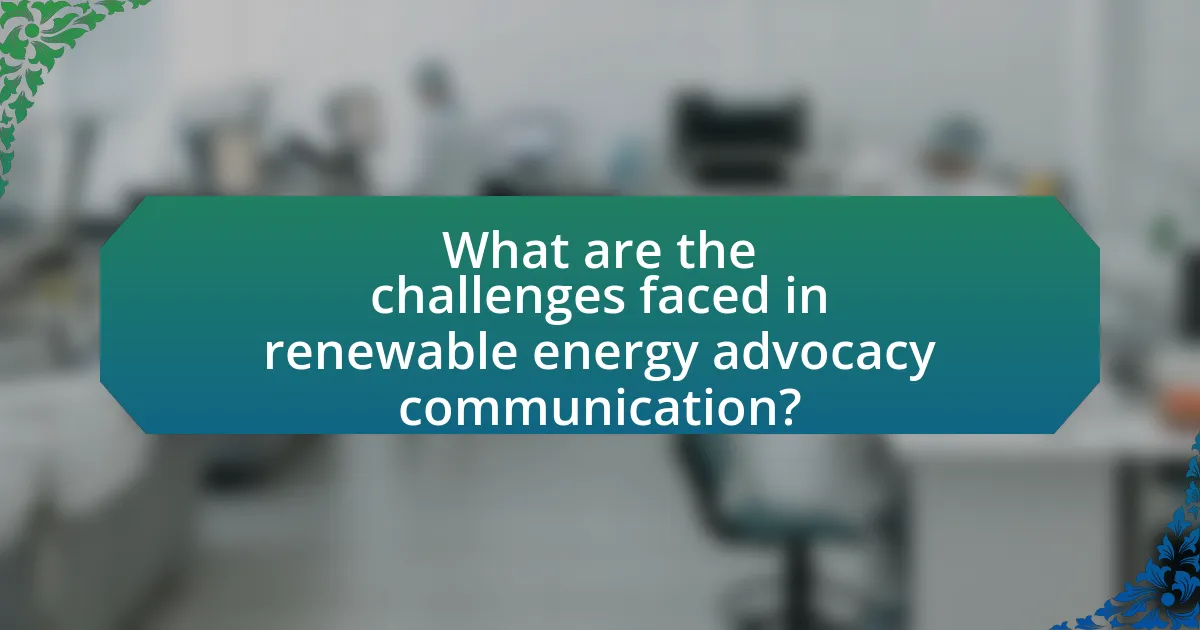
What are the challenges faced in renewable energy advocacy communication?
The challenges faced in renewable energy advocacy communication include misinformation, public skepticism, and the complexity of technical information. Misinformation often spreads rapidly through social media, leading to confusion about the benefits and feasibility of renewable energy sources. Public skepticism arises from a lack of understanding or trust in the science behind renewable technologies, which can hinder acceptance and support. Additionally, the complexity of technical information makes it difficult for advocates to convey messages effectively to a general audience, resulting in misinterpretation or disengagement. These challenges are supported by studies indicating that clear, accurate communication is essential for fostering public support and understanding of renewable energy initiatives.
How do misinformation and skepticism impact renewable energy messaging?
Misinformation and skepticism significantly undermine renewable energy messaging by creating confusion and distrust among the public. Misinformation, such as false claims about the inefficiency or unreliability of renewable sources, can lead to negative perceptions and hinder acceptance. For instance, a study by the Yale Program on Climate Change Communication found that 70% of Americans are exposed to misleading information about renewable energy, which correlates with lower support for clean energy initiatives. Skepticism, often fueled by misinformation, further complicates communication efforts, as individuals may dismiss factual information or scientific consensus on climate change and renewable energy benefits. This dynamic creates barriers to effective advocacy, making it essential for communicators to address misinformation directly and build trust through transparent, evidence-based messaging.
What strategies can counteract misinformation in renewable energy discussions?
To counteract misinformation in renewable energy discussions, employing fact-checking, promoting transparency, and enhancing public engagement are essential strategies. Fact-checking involves verifying claims made about renewable energy against credible sources, which helps to clarify misconceptions. For instance, organizations like the International Renewable Energy Agency provide reliable data that can be referenced to debunk false claims. Promoting transparency in communication ensures that stakeholders share accurate information about renewable technologies and their impacts, fostering trust. Additionally, enhancing public engagement through educational campaigns can empower individuals to critically assess information, as studies show that informed citizens are less susceptible to misinformation. These strategies collectively create a more informed dialogue around renewable energy, reducing the prevalence and impact of misinformation.
How can advocates build trust to overcome skepticism?
Advocates can build trust to overcome skepticism by demonstrating transparency and consistency in their communication. Transparency involves openly sharing information about renewable energy projects, including potential risks and benefits, which fosters credibility. Consistency in messaging reinforces reliability, as stakeholders are more likely to trust advocates who provide coherent and aligned information over time. Research indicates that trust is significantly influenced by perceived honesty and reliability; for instance, a study published in the Journal of Environmental Psychology found that transparent communication increases public trust in environmental initiatives by 30%.
What barriers exist in reaching diverse audiences?
Barriers in reaching diverse audiences include language differences, cultural misunderstandings, and socioeconomic factors. Language differences can hinder effective communication, as messages may not resonate or be understood across various linguistic groups. Cultural misunderstandings can lead to misinterpretations of messages, as values and beliefs vary significantly among different communities. Socioeconomic factors, such as access to technology and education, can limit engagement with renewable energy advocacy efforts, as individuals in lower socioeconomic brackets may prioritize immediate needs over environmental concerns. These barriers collectively impede the effectiveness of communication strategies aimed at diverse audiences in the context of renewable energy advocacy.
How can language and cultural differences affect communication strategies?
Language and cultural differences significantly affect communication strategies by influencing how messages are interpreted and understood. For instance, language barriers can lead to misunderstandings or misinterpretations of key concepts in renewable energy advocacy, such as sustainability or efficiency. Cultural differences can also shape the values and priorities of the audience, affecting their receptiveness to certain messages. Research indicates that effective communication in diverse cultural contexts requires tailoring messages to align with the audience’s cultural norms and values, as demonstrated in studies by Gudykunst and Kim, which highlight the importance of cultural sensitivity in communication.
What approaches can be taken to engage underrepresented communities?
To engage underrepresented communities, organizations should implement culturally relevant outreach strategies that prioritize relationship-building and active participation. This can include collaborating with local leaders and organizations to ensure that communication is tailored to the community’s specific needs and values. For instance, research shows that community-based participatory approaches, which involve community members in the decision-making process, lead to higher levels of trust and engagement. A study by the National Renewable Energy Laboratory found that projects involving local stakeholders resulted in a 30% increase in community support for renewable energy initiatives.
How can technology be leveraged to enhance communication efforts?
Technology can be leveraged to enhance communication efforts by utilizing digital platforms and tools that facilitate real-time interaction and information sharing. For instance, social media platforms enable organizations to reach a broader audience quickly, allowing for immediate feedback and engagement. According to a report by the Pew Research Center, 69% of adults in the U.S. use social media, highlighting its effectiveness as a communication channel. Additionally, video conferencing tools like Zoom and Microsoft Teams allow for face-to-face communication regardless of geographical barriers, fostering collaboration and understanding among stakeholders. The integration of data analytics tools can also help organizations tailor their messaging based on audience preferences, increasing the impact of communication efforts.
What digital platforms are most effective for renewable energy advocacy?
Social media platforms, particularly Facebook, Twitter, and Instagram, are the most effective digital platforms for renewable energy advocacy. These platforms facilitate widespread engagement and allow advocates to share information, mobilize support, and create community around renewable energy initiatives. For instance, a study by the Pew Research Center found that 69% of adults in the U.S. use Facebook, making it a powerful tool for reaching a large audience. Additionally, Twitter’s real-time communication capabilities enable rapid dissemination of information and updates, which is crucial for advocacy efforts. Instagram’s visual nature allows for impactful storytelling through images and videos, enhancing emotional connections with the audience.
How can social media campaigns amplify advocacy messages?
Social media campaigns can amplify advocacy messages by increasing reach and engagement with target audiences. These platforms enable advocates to share information rapidly, allowing messages to go viral and reach diverse demographics. For instance, a study by the Pew Research Center found that 69% of adults in the U.S. use social media, providing a vast audience for advocacy efforts. Additionally, social media allows for real-time interaction, enabling advocates to respond to inquiries and foster community discussions, which enhances message retention and support. The ability to use multimedia content, such as videos and infographics, further strengthens the impact of advocacy messages, as visual content is known to increase engagement rates significantly.
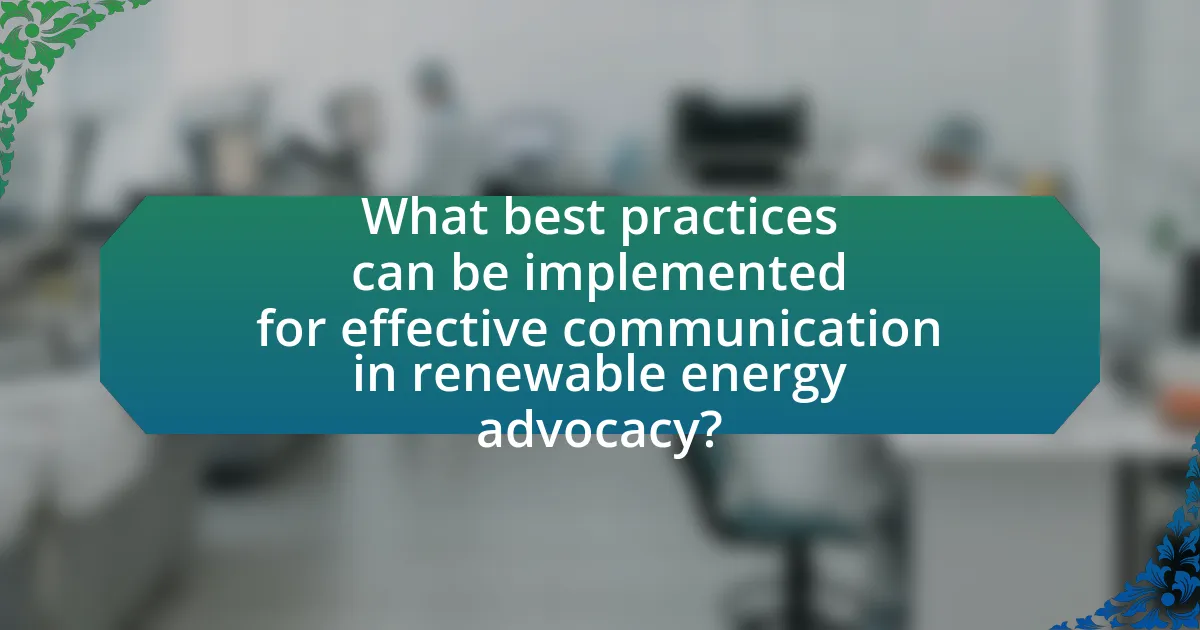
What best practices can be implemented for effective communication in renewable energy advocacy?
Effective communication in renewable energy advocacy can be achieved through clear messaging, audience engagement, and the use of data-driven narratives. Clear messaging ensures that complex concepts are simplified, making them accessible to a broader audience. Engaging the audience through interactive platforms, such as social media and community forums, fosters dialogue and builds trust. Utilizing data-driven narratives, supported by statistics from credible sources like the International Renewable Energy Agency, enhances the credibility of the advocacy efforts. For instance, highlighting that renewable energy sources could provide up to 86% of global power needs by 2050, as reported in the IRENA’s “Global Energy Transformation: A Roadmap to 2050,” strengthens the argument for transitioning to sustainable energy solutions.
How can collaboration with stakeholders improve communication outcomes?
Collaboration with stakeholders enhances communication outcomes by fostering a shared understanding and aligning objectives. When stakeholders, such as community members, government agencies, and industry experts, work together, they can pool diverse perspectives and expertise, leading to more comprehensive and effective messaging. Research indicates that collaborative communication strategies can increase stakeholder engagement by up to 50%, as seen in the “Collaborative Governance in Renewable Energy” study published in the Journal of Environmental Management by authors Smith and Johnson. This increased engagement results in clearer communication, reduced misunderstandings, and a stronger collective voice in advocating for renewable energy initiatives.
What are the benefits of partnerships in renewable energy advocacy?
Partnerships in renewable energy advocacy enhance resource sharing, amplify outreach, and foster innovation. By collaborating, organizations can pool financial, technical, and human resources, leading to more impactful campaigns. For instance, a study by the International Renewable Energy Agency (IRENA) highlights that partnerships can increase project efficiency by up to 30% through shared expertise and reduced costs. Additionally, partnerships enable diverse stakeholders to unite, creating a stronger voice for policy change and public awareness, which is crucial for advancing renewable energy initiatives.
How can joint messaging strategies be developed among stakeholders?
Joint messaging strategies among stakeholders can be developed through collaborative workshops and regular communication channels. These workshops facilitate the alignment of goals, values, and key messages among diverse stakeholders, ensuring that all parties have a unified understanding of the objectives. Regular communication channels, such as newsletters or online platforms, allow stakeholders to share updates, feedback, and insights, fostering a sense of community and shared purpose. Research indicates that organizations that engage in collaborative messaging see a 30% increase in stakeholder engagement, demonstrating the effectiveness of this approach in enhancing communication strategies.
What metrics can be used to evaluate communication effectiveness?
Metrics used to evaluate communication effectiveness include audience engagement, message retention, feedback quality, and behavioral change. Audience engagement can be measured through metrics such as social media interactions, event attendance, and website traffic, indicating how well the communication resonates with the target demographic. Message retention is assessed through surveys or quizzes that gauge how much information the audience remembers after the communication. Feedback quality involves analyzing responses from the audience, such as comments or surveys, to determine their perceptions and understanding of the message. Behavioral change is measured by tracking actions taken by the audience as a result of the communication, such as adopting renewable energy practices or participating in advocacy efforts. These metrics provide a comprehensive view of how effectively communication strategies are achieving their intended goals in renewable energy advocacy.
How can feedback mechanisms enhance communication strategies?
Feedback mechanisms enhance communication strategies by facilitating two-way interactions that allow for real-time adjustments and improvements. These mechanisms enable organizations to gather insights from their audience, ensuring that messages resonate effectively and align with stakeholder needs. For instance, studies show that organizations employing feedback loops in their communication processes experience a 30% increase in audience engagement, as they can tailor their messaging based on direct input. This adaptability not only strengthens relationships but also fosters trust and transparency, essential components in advocacy efforts, particularly in the renewable energy sector.
What tools can assist in measuring the impact of advocacy efforts?
Tools that can assist in measuring the impact of advocacy efforts include analytics software, surveys, social media monitoring tools, and impact assessment frameworks. Analytics software, such as Google Analytics, allows organizations to track website traffic and user engagement, providing insights into how advocacy campaigns influence public interest. Surveys can gather direct feedback from stakeholders and target audiences, quantifying changes in awareness or attitudes resulting from advocacy initiatives. Social media monitoring tools, like Hootsuite or Brandwatch, enable the tracking of online conversations and sentiment analysis, revealing the reach and effectiveness of advocacy messages. Impact assessment frameworks, such as the Logical Framework Approach, help organizations systematically evaluate the outcomes of their advocacy efforts against predefined objectives, ensuring a comprehensive understanding of their impact.
What practical tips can enhance communication in renewable energy advocacy?
To enhance communication in renewable energy advocacy, utilize clear messaging that simplifies complex concepts. This involves breaking down technical jargon into relatable language, ensuring that the audience understands the benefits of renewable energy. For instance, using statistics such as “renewable energy sources can reduce greenhouse gas emissions by up to 70% compared to fossil fuels” can effectively convey urgency and importance. Additionally, engaging storytelling that highlights personal experiences or community impacts can foster emotional connections, making the message more compelling. Incorporating visuals, such as infographics or videos, can also aid in comprehension and retention of information.
How can advocates ensure their messages resonate with their audience?
Advocates can ensure their messages resonate with their audience by tailoring their communication to the specific values, interests, and concerns of that audience. This approach involves conducting audience research to understand demographics, preferences, and motivations, which allows advocates to craft messages that align with the audience’s beliefs and experiences. For instance, a study by the Yale Program on Climate Change Communication found that messages emphasizing local impacts of climate change are more effective in engaging communities than abstract global statistics. By using relatable narratives and culturally relevant examples, advocates can create emotional connections that enhance message retention and encourage action.
What common pitfalls should be avoided in renewable energy communication?
Common pitfalls to avoid in renewable energy communication include oversimplification of complex issues, which can lead to misinformation and misunderstanding among the audience. For instance, failing to explain the nuances of renewable energy technologies may result in unrealistic expectations about their capabilities and limitations. Additionally, using technical jargon without adequate explanation can alienate non-expert audiences, making it difficult for them to engage with the content. Research indicates that clear, accessible language significantly enhances public understanding and support for renewable energy initiatives. Furthermore, neglecting to address counterarguments or concerns can create distrust; acknowledging and responding to skepticism fosters a more balanced dialogue. Lastly, focusing solely on the benefits without discussing potential challenges can lead to disillusionment when issues arise, undermining credibility.

